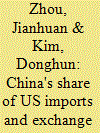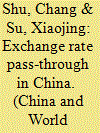|
|
|
Sort Order |
|
|
|
Items / Page
|
|
|
|
|
|
|
| Srl | Item |
| 1 |
ID:
105076


|
|
|
|
|
| Publication |
2011.
|
| Summary/Abstract |
The present paper investigates the effect of China's share of US imports on the aggregate-level exchange rate pass-through to US import prices over the period from January 1999 to December 2008. The paper also focuses on the post-reform period, after 2005, allowing greater flexibility of the RMB to explore the change in the role of the Chinese import share in determining the trend in the US exchange rate pass-through. Evidence reveals that China's share of US imports has a negative effect on the exchange rate pass-through. However, this negative effect has been moderated to a negligible level since China's exchange rate reform. An important implication is that the exchange rate flexibility of the RMB has been raised to a significant level may no longer cause distortion in the US competitive environment and prevent the USA from adjusting current accounts.
|
|
|
|
|
|
|
|
|
|
|
|
|
|
|
|
| 2 |
ID:
103944


|
|
|
|
|
| Publication |
2011.
|
| Summary/Abstract |
This article investigates the exchange rate pass-through for Indian export and import prices. A markup model for aggregate export/import prices is set up, and the analysis is carried out using Johansen-Juselius cointegration and error correction models. The evidence shows partial pass-through into export prices, but more than complete pass-through into import prices, with the long-run pass-through coefficients being larger than the short-run coefficients. Thus, the Indian exporter does appear to have a little bargaining power, but it is not so with the Indian importer. The results cast a question mark over the efficacy of exchange rate changes as a policy tool in correcting trade balances, and also point to the risk of imported inflation.
|
|
|
|
|
|
|
|
|
|
|
|
|
|
|
|
| 3 |
ID:
086474


|
|
|
|
|
| Publication |
2009.
|
| Summary/Abstract |
During the second half of 2007 and early part of 2008 when there were intense inflationary pressures in China, RMB appreciation was advocated as a means of helping to curb inflation. The effectiveness of appreciation in controlling inflation depends on the impact of exchange rate movements on import and domestic prices. Our analysis finds fairly large and speedy exchange rate pass-through (ERPT) to import prices: 50 and 60 percent for the short run and long run, respectively. However, the degree of ERPT decreases along the price chain from upstream to downstream prices. ERPT for consumer prices, the most downstream prices, is much milder and has substantial lags. A 10-percent rise in the nominal effective exchange rate will dampen consumer prices by 1.1 percent within a year, with very little pass-through in the first half year, and by 2.0 percent over the long run. These findings, particularly the ERPT to consumer prices, suggest that RMB appreciation can help to reduce inflationary pressures over the longer term. However, it is unlikely to provide rapid relief to the current round of high inflation because of the long lags in ERPT. The RMB needs to strengthen in effective terms to exert the desired dampening impact on prices.
|
|
|
|
|
|
|
|
|
|
|
|
|
|
|
|
| 4 |
ID:
144858


|
|
|
|
|
| Summary/Abstract |
Exchange rate movement usually results in changes in the production costs of exporting firms, and, therefore, the prices and the quantity of traded products. The present paper constructs a theoretical model to demonstrate that export products with higher productivity, or with larger market share, or of higher quality will experience a less complete pass-through. Using the six-digit harmonized system export data from the CEPII database over the period of 2000 to 2013, the present paper examines how product heterogeneity affects the exchange rate pass-through of Chinese exports. The empirical results show that the most competitive Chinese export products, or those least affected by exchange rate risks, are those of higher quality, with higher technological complexity and at the high end of the international value chain. Therefore, Chinese exporting firms should pay more attention to improving export quality and upgrading technology to better cope with exchange rate risks and to enjoy more bargaining power in the international market.
|
|
|
|
|
|
|
|
|
|
|
|
|
|
|
|
|
|
|
|
|